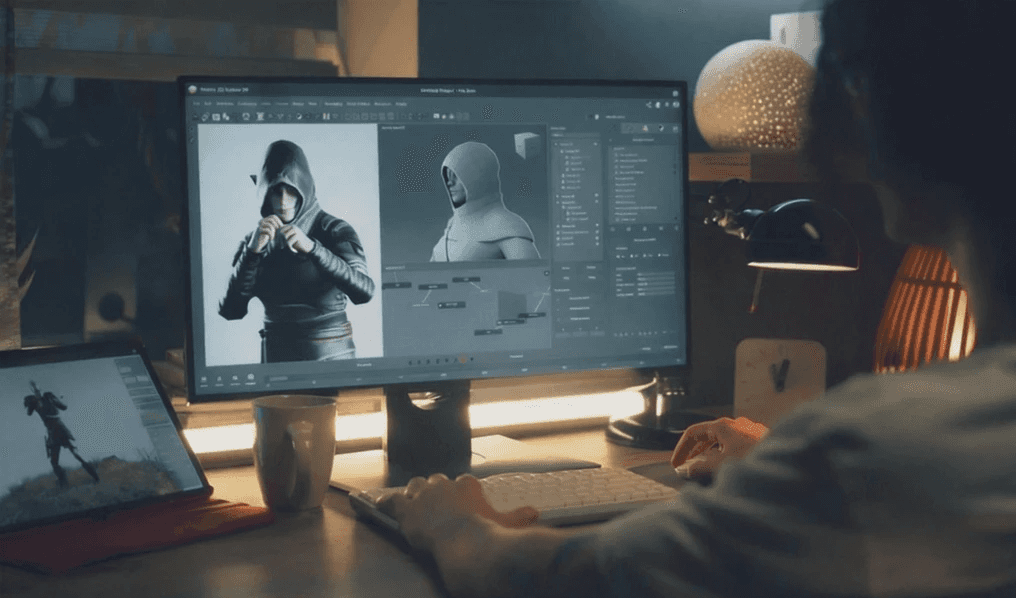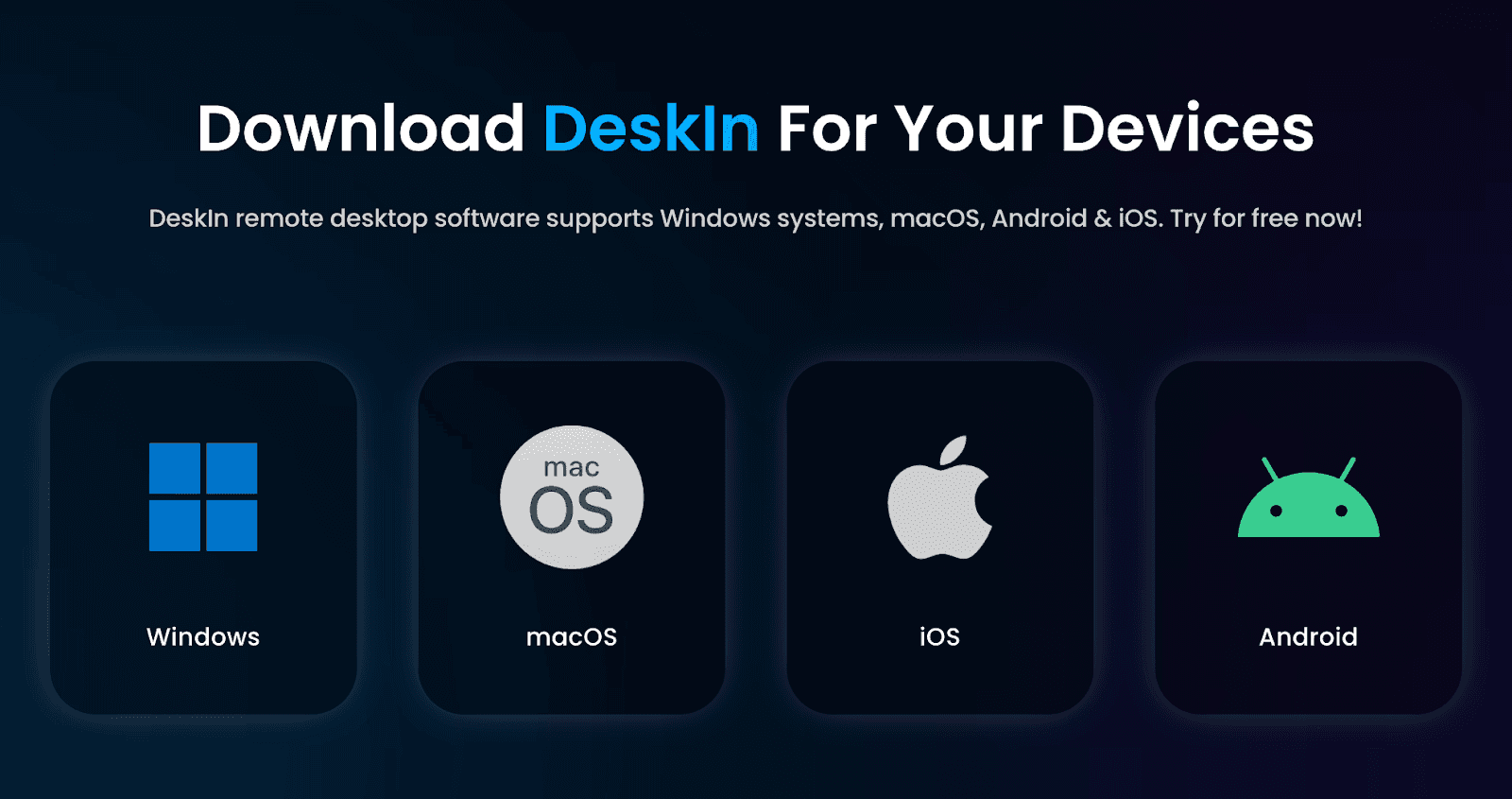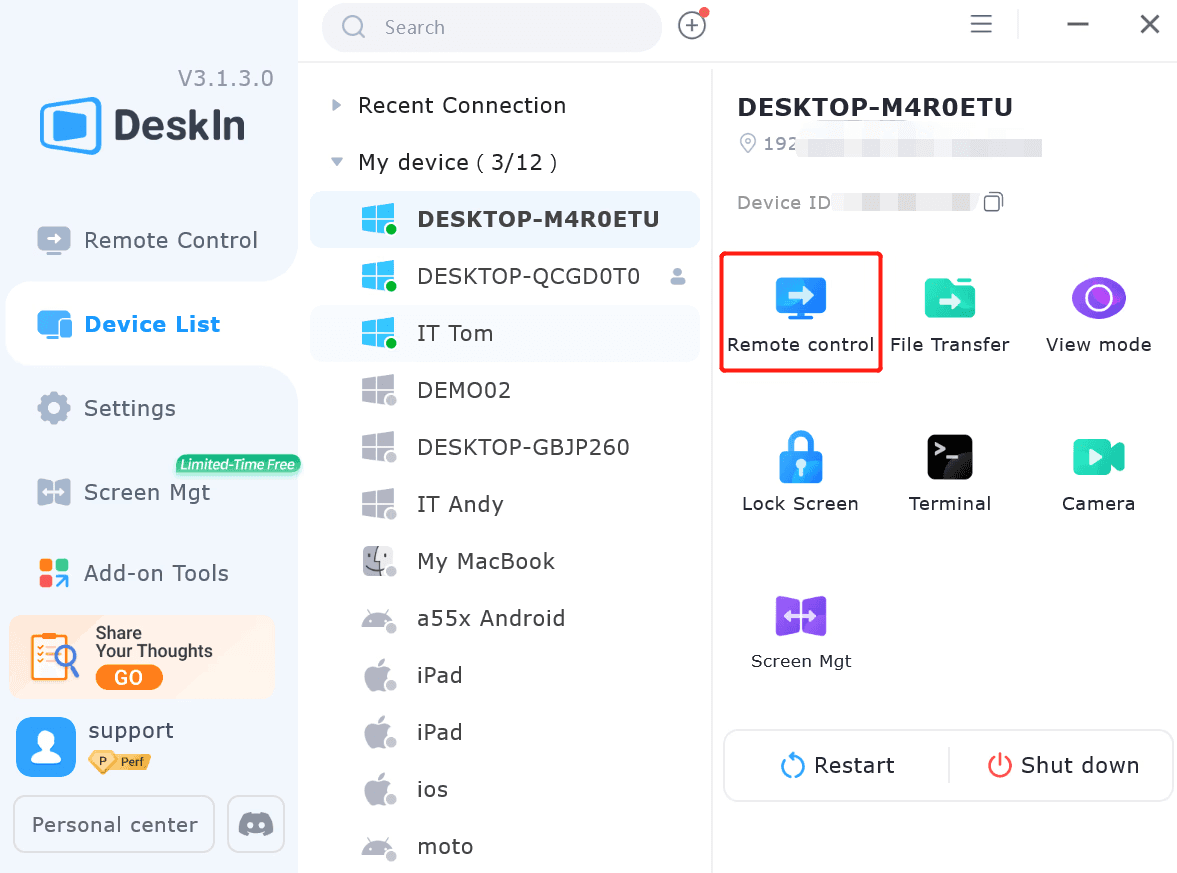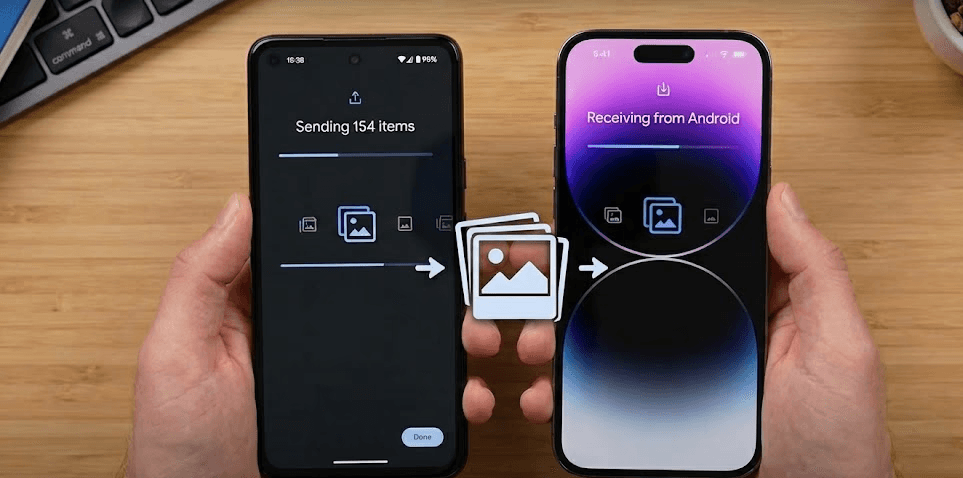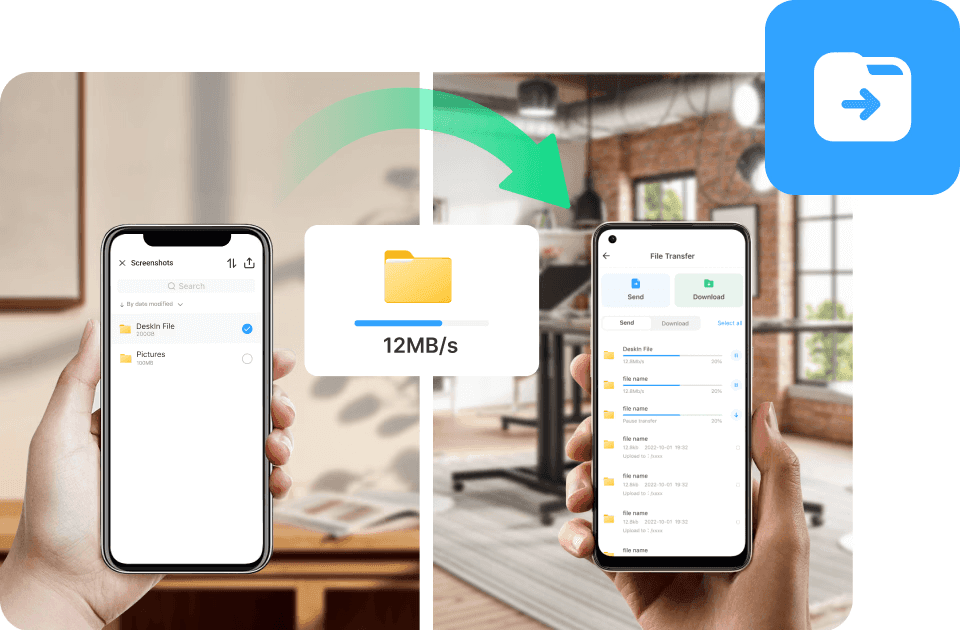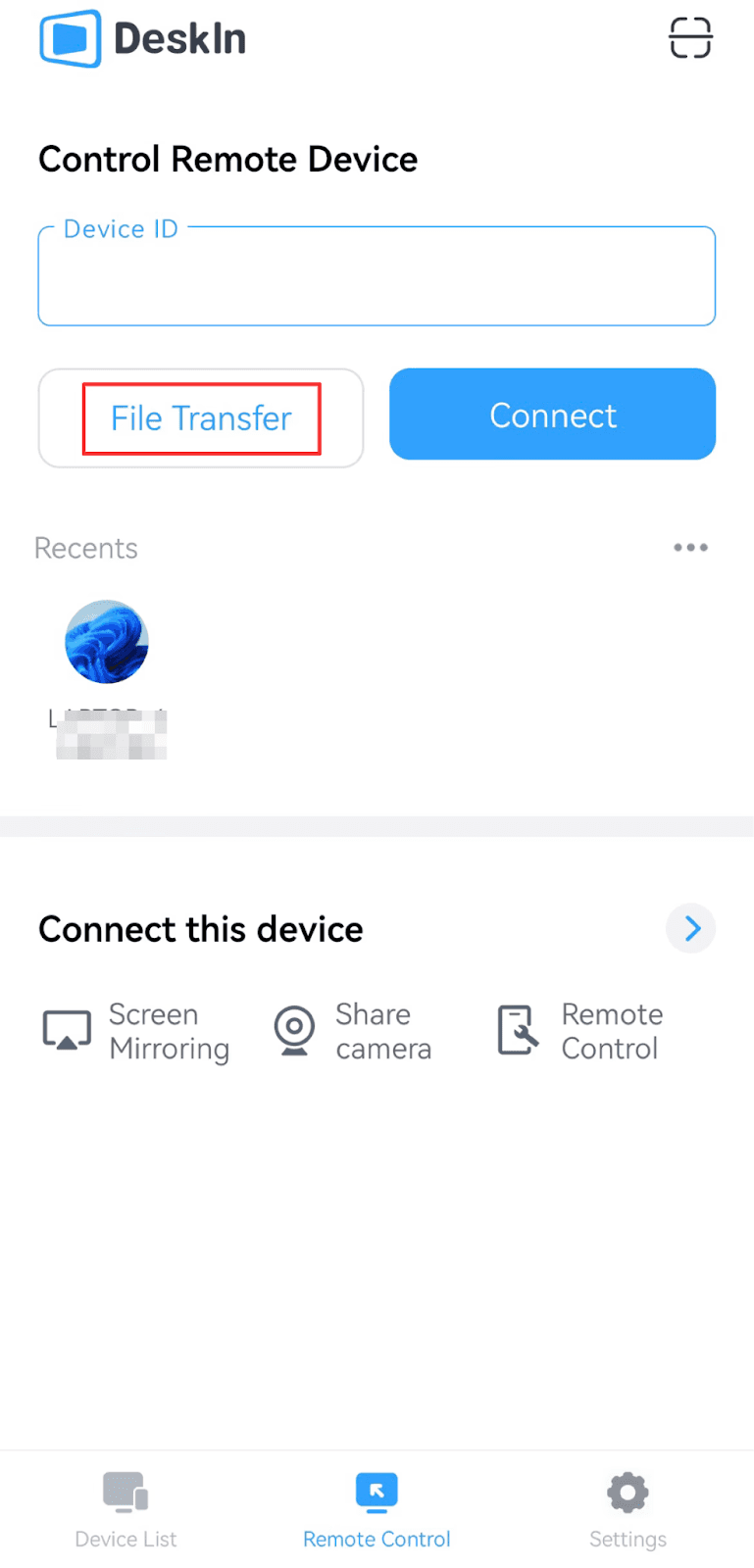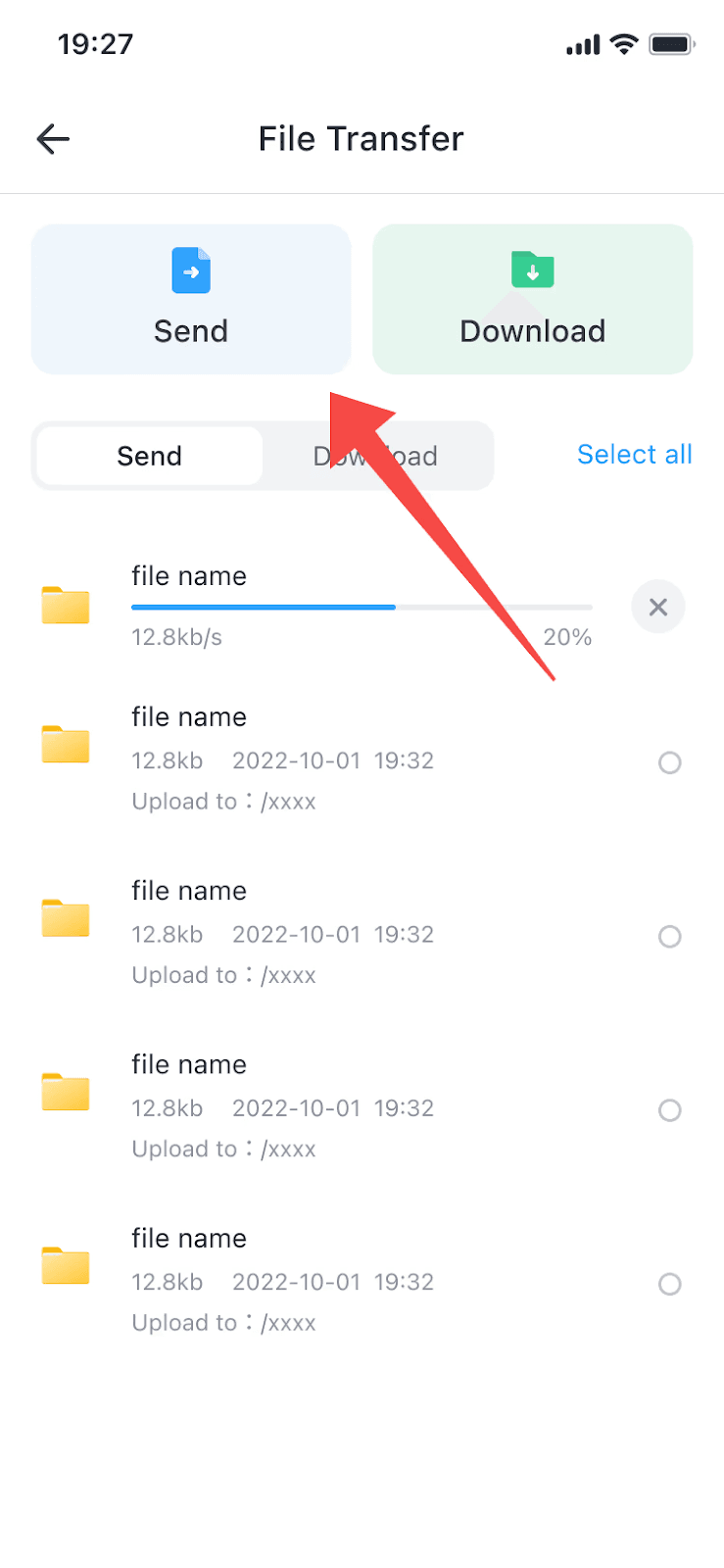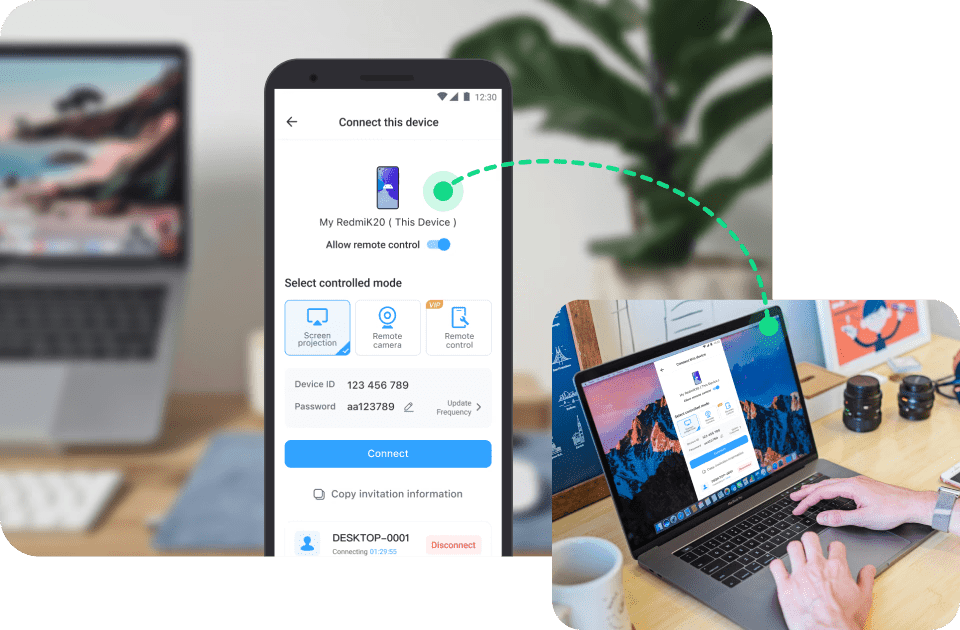Microsoft Remote Desktop is awesome! After all, it’s free, built into Windows, and promises seamless access to your computer anywhere. Yet, the first time you try connecting across networks, the process feels like solving a digital escape room. Finding the IP addresses, checking firewall settings. No wonder questions like “Why won't my RDC connect?!” or "Help! Connection error" explodes daily on Reddit. Enough frustration.
In this guide, we'll walk you through every click, setting, address common issues you might encounter, and introduce a powerful alternative (Spoiler: DeskIn) for those can't use RDC on Windows. Follow along, and in 15 minutes, you’ll control your PC remotely!
Do You Know: Microsoft RDC Now Officially A Windows App
Microsoft Remote Desktop Shutting Down: All You Need to Know
Microsoft RDC Replaced: Welcome to the New Windows App for Remote Access
Quick Rundown: 6 Things to Check Before Using RDC
RDC isn't for everyone. It's not accessible for users who use Windows Home or don't have admin rights on the computer you want to access remotely. Beyond these limitations, a stable internet connection is a must. So, before you begin, make sure you tick off the following checklist to ensure a successful setup.
Quick checklist before using RDC:T
he host device uses Windows 10/11 Pro or Enterprise
Both devices are connected – the same LAN preferred, else VPN/public IP
The host PC stays on and awake
Port 3389 is open on the firewall
You know the IP address and login credentials
Mannual toggle on the "Remote Desktop" feature
Do note that setting up Remote Desktop can be a bit complicated. A simpler and faster way might be to use DeskIn. It is easier to use, gives you more remote access features, and has a nicer look. Go to Method 3 below for more details!
1. Set Up Remote Desktop Connection on Windows 10/11
Now that you've confirmed your setup meets the system requirements, let's walk through how to set up a Remote Desktop Connection on Windows 10/11. This method works best if you're on a compatible Windows edition and have access credentials for the remote device.
If you're using a Mac, you'll find a dedicated solution in the next part. Feel free to skip ahead for platform-specific instructions.
Step 1. Enable Remote Desktop on the host PC
To begin, press Win + I to open the Settings app. Navigate to System > Remote Desktop, then toggle on Enable Remote Desktop and confirm the prompt.

Note: The Remote Desktop Connection feature has system requirements. If you are a Windows Home user, you may not be able to enable it. If you encounter similar problems, please read the post below for more information.
How to Enable Remote Desktop Windows 10: Easy Guide & Error Fixes
[Ultimate Guide] 2 Simple Ways to Share Windows 10/11 Screen
Step 2. Launch Remote Desktop Connection on your local device
On your local computer (whether it's a Windows PC, Mac, or another device), you need to open the Remote Desktop Connection application. On Windows, you can do this by pressing "Win + R" to open the Run dialog, then typing "mstsc" and hitting Enter. Alternatively, you can search for Remote Desktop Connection in the Start menu.
Step 3. Enter the remote computer's address
In the Remote Desktop Connection window that opens, you'll be asked to enter the IP address or computer name of the remote PC you want to connect to.
You can find this information on the remote PC by following the steps mentioned in the previous section (Settings > System > About > Device Name). After entering the correct details, click "Connect".
Step 4. Log in to the remote device
Once you click "Connect", a login prompt will appear. Enter the username and password of an account that has remote access rights on the target PC. This could be your admin account or any user account you've granted access to.

After logging in, you'll see the remote Windows desktop appear on your local screen, allowing you to control the PC as if you were sitting in front of it.
Still too complicated? Need a simpler alternative?
For secure, simple remote control across platforms, DeskIn offers enterprise-grade performance with zero firewall hassle. It only requires 3 easy steps to connect your PCs.
👉 Click here to download DeskIn
2. Connect Mac to Windows via RDP
While Remote Desktop Connection (RDC) is a powerful tool for connecting Windows machines, it's not natively available on Macs. This is because RDC is specifically designed for Windows environments, and Apple's operating system doesn't support it directly.
However, the good news is that you still use Windows Remote Desktop Protocol (RDP) to connect to a Mac
using the ). RDP is a versatile protocol that allows you to connect to Windows machines from various devices, including Macs by using compatible client software. Below is a step-by-step guide that shows how to connect Remote Desktop on a Mac to Windows, making it easy to access your Windows environment from your macOS device.
Step 1. Get the Microsoft Windows App program for your Mac
You will need a locally installed RDP client (a program that lets you connect to Windows computers that have RDP enabled). If you don't have one, we recommend getting the Windows App from the Mac App Store. Once you have it installed, you can proceed.
Step 2. Open Windows App
Press +, and then select "Desktop" to set up a new connection.
Step 3. Fill out connection information
Give the connection a name in the "Friendly name" field. Specify the fully qualified domain name of the Windows computer to which you wish to connect via RDP. Press "Add" to add the desktop connection.

Step 4. Start the RDP connection
Then, double-click on the connection to connect. You will be prompted for your username and password. Enter your MCECS username as cecs\username. Note the "cecs\" that precedes your username.

Troubleshooting Remote Desktop Connection Not Working on Windows
If you're trying to connect two computers using a remote desktop connection app for Windows but the session won't start, try these fixes:
Check firewall settings: Open Control Panel, go to Windows Defender Firewall > Allow an app through firewall, and make sure "Remote Desktop" is enabled.
Verify Remote Desktop Services: Search "Services" from the Start menu, find "Remote Desktop Services," and start it if it's not running.
Use the computer's IP address: Run
ipconfigon the remote PC to get its IP, then use that in your RDP connection instead of the hostname.Disable TCP/IPv6: Go to Network and Sharing Center > Change adapter settings, right-click your connection, open Properties, uncheck "Internet Protocol Version 6," and click OK.
Switch to a local account: Go to Settings > Accounts > Family & other users, create a new local admin account, and try connecting with that.
3. Better Alternative: Connect to Your Windows PC in 3 Minutes with DeskIn
If you're looking for a more stable and easier remote desktop experience, try DeskIn. It can be the best alternative to the default remote desktop connection app in both speed and usability. Unlike traditional RDP or RDC, DeskIn lets you connect across cities and different networks without requiring a public IP address or complex router configuration.
This remote desktop software offers seamless cross-platform compatibility, making it easy to control your Windows PC from Mac, or even mobile devices. While connectiong to another computer, it supports file transfer, voice calls, whiteboard collaboration, and more — ideal for remote work, technical support, or distance learning.
Whether you're looking for the best remote desktop program for daily use or free remote desktop software with professional features, DeskIn makes connecting easy, secure, and fast — all within just 3 minutes.
👉 Click here to download DeskIn

Why DeskIn is the Smarter Choice?
High Stability and Ultra-Low Latency: With over 200 global acceleration nodes, DeskIn ensures stable, high-speed remote connections — even across continents. Unlike Remote Desktop Connection, which often lags on weaker networks, DeskIn keeps your operations smooth and responsive in any environment.
No Public IP or Complex Setup Needed: Forget about port forwarding, VPNs, or public IP addresses. DeskIn simplifies everything: just install the app, log in, and start controlling your PC — no technical barriers.
Access Anytime from PC, Mobile, or Tablet: DeskIn supports Windows, macOS, iOS, and Android, giving you full control across devices. Compared to Remote Desktop Connection, DeskIn's mobile access is faster, easier, and needs no extra configuration.
Free for Commercial Use: DeskIn's free plan allows remote control of up to three devices, even for business needs — a major advantage over Remote Desktop, which may require additional licensing depending on your Windows edition.
Perfect for Any Scenario: Whether working remotely, gaming, supporting clients, or transferring files on the go, DeskIn adapts effortlessly. It offers smart features like automatic resolution adjustment, session reconnection, and robust encryption for secure access.
Connect to Your Windows PC Anywhere with DeskIn
Do you want full control of your PC from anywhere, in just under 3 minutes? DeskIn makes it simple, even for first-time users. Here's how to remote into a computer using DeskIn:
Step 1. First, head over to DeskIn's official website and download the appropriate version for your device — whether it's Windows, macOS, iOS, or Android. After downloading, install the app following the on-screen instructions.
👉 Click here to download DeskIn
Step 2. Once installed, open the DeskIn application. If you already have an account, simply log in with your credentials. If you're a new user, you can quickly create an account within minutes — it's completely free.

Step 3. After logging in, just use the device ID and password on your target PC to connect. Then, select the Windows PC you want to control and initiate the connection. Now, you'll gain full remote access, enabling you to work, manage files, or troubleshoot issues from virtually anywhere.

Recommended Reading
Compare DeskIn vs. Microsoft Remote Desktop App
Microsoft's Remote Desktop App requires no extra installation, offers deep system integration, and is free, making it especially practical for IT professionals and enterprise users. In contrast, DeskIn eliminates port forwarding and public IP needs, enabling non-technical users to quickly get started. It delivers higher remote efficiency, even on low-speed networks, and supports remote support, training, and collaboration scenarios far beyond simple remote control.
Check the table below for a detailed comparison of these remote desktop connection software options and learn more about remote access to Windows from a device.
Feature | DeskIn Connection | Remote Desktop Connection |
|---|---|---|
Connection Stability | Very stable, with high availability | May experience interruptions on weaker networks |
Compatibility | Supports Windows, macOS, iOS, and Android | Only available for Windows PCs |
Mobile Support | Full mobile/tablet support | Limited mobile/tablet options |
Setup | Easy, no public IP required | Requires network configuration and a public IP |
Ease of Use | Install & connect easily | Requires enabling system settings and firewall rules |
Free Version for Business | Yes, up to 3 devices | Limited, requires the correct Windows edition |
FAQs: Remote Desktop Connection for Windows
What is the best remote desktop program for Windows?
DeskIn is the best secure remote desktop program for Windows. It stands out with 3-step setup and cross-platform compatibility. DeskIn also offers easy cross-network connections without a public IP or complex setup. Besides, the remote desktop software for Windows provides features for remote connections like file transfer, whiteboard, and voice calls for versatile use.
Is Windows Remote Desktop Connection safe?
Windows Remote Desktop Connection (RDC) is not inherently safe. Many users expose RDC to public networks and use weak, repetitive passwords, making it easy for hackers to crack and gain unauthorized access. To avoid the risks and get the solutions, check our guide:
Final Thoughts: Enable Secure & Flexible Remote Desktop Access
In conclusion, whether you choose Remote Desktop Connection on Windows or switch to a more advanced tool like DeskIn, both options can enhance your remote desktop experience, making it more efficient and accessible.
While Remote Desktop Connection is a reliable solution for basic remote access, DeskIn offers higher stability, better compatibility across devices, and a more seamless connection for various use cases. By selecting the right tool based on your needs, you can enjoy a smoother and more productive remote working experience.
👉 Click here to download DeskIn
Microsoft Remote Desktop is awesome! After all, it’s free, built into Windows, and promises seamless access to your computer anywhere. Yet, the first time you try connecting across networks, the process feels like solving a digital escape room. Finding the IP addresses, checking firewall settings. No wonder questions like “Why won't my RDC connect?!” or "Help! Connection error" explodes daily on Reddit. Enough frustration.
In this guide, we'll walk you through every click, setting, address common issues you might encounter, and introduce a powerful alternative (Spoiler: DeskIn) for those can't use RDC on Windows. Follow along, and in 15 minutes, you’ll control your PC remotely!
Do You Know: Microsoft RDC Now Officially A Windows App
Microsoft Remote Desktop Shutting Down: All You Need to Know
Microsoft RDC Replaced: Welcome to the New Windows App for Remote Access
Quick Rundown: 6 Things to Check Before Using RDC
RDC isn't for everyone. It's not accessible for users who use Windows Home or don't have admin rights on the computer you want to access remotely. Beyond these limitations, a stable internet connection is a must. So, before you begin, make sure you tick off the following checklist to ensure a successful setup.
Quick checklist before using RDC:T
he host device uses Windows 10/11 Pro or Enterprise
Both devices are connected – the same LAN preferred, else VPN/public IP
The host PC stays on and awake
Port 3389 is open on the firewall
You know the IP address and login credentials
Mannual toggle on the "Remote Desktop" feature
Do note that setting up Remote Desktop can be a bit complicated. A simpler and faster way might be to use DeskIn. It is easier to use, gives you more remote access features, and has a nicer look. Go to Method 3 below for more details!
1. Set Up Remote Desktop Connection on Windows 10/11
Now that you've confirmed your setup meets the system requirements, let's walk through how to set up a Remote Desktop Connection on Windows 10/11. This method works best if you're on a compatible Windows edition and have access credentials for the remote device.
If you're using a Mac, you'll find a dedicated solution in the next part. Feel free to skip ahead for platform-specific instructions.
Step 1. Enable Remote Desktop on the host PC
To begin, press Win + I to open the Settings app. Navigate to System > Remote Desktop, then toggle on Enable Remote Desktop and confirm the prompt.

Note: The Remote Desktop Connection feature has system requirements. If you are a Windows Home user, you may not be able to enable it. If you encounter similar problems, please read the post below for more information.
How to Enable Remote Desktop Windows 10: Easy Guide & Error Fixes
[Ultimate Guide] 2 Simple Ways to Share Windows 10/11 Screen
Step 2. Launch Remote Desktop Connection on your local device
On your local computer (whether it's a Windows PC, Mac, or another device), you need to open the Remote Desktop Connection application. On Windows, you can do this by pressing "Win + R" to open the Run dialog, then typing "mstsc" and hitting Enter. Alternatively, you can search for Remote Desktop Connection in the Start menu.
Step 3. Enter the remote computer's address
In the Remote Desktop Connection window that opens, you'll be asked to enter the IP address or computer name of the remote PC you want to connect to.
You can find this information on the remote PC by following the steps mentioned in the previous section (Settings > System > About > Device Name). After entering the correct details, click "Connect".
Step 4. Log in to the remote device
Once you click "Connect", a login prompt will appear. Enter the username and password of an account that has remote access rights on the target PC. This could be your admin account or any user account you've granted access to.

After logging in, you'll see the remote Windows desktop appear on your local screen, allowing you to control the PC as if you were sitting in front of it.
Still too complicated? Need a simpler alternative?
For secure, simple remote control across platforms, DeskIn offers enterprise-grade performance with zero firewall hassle. It only requires 3 easy steps to connect your PCs.
👉 Click here to download DeskIn
2. Connect Mac to Windows via RDP
While Remote Desktop Connection (RDC) is a powerful tool for connecting Windows machines, it's not natively available on Macs. This is because RDC is specifically designed for Windows environments, and Apple's operating system doesn't support it directly.
However, the good news is that you still use Windows Remote Desktop Protocol (RDP) to connect to a Mac
using the ). RDP is a versatile protocol that allows you to connect to Windows machines from various devices, including Macs by using compatible client software. Below is a step-by-step guide that shows how to connect Remote Desktop on a Mac to Windows, making it easy to access your Windows environment from your macOS device.
Step 1. Get the Microsoft Windows App program for your Mac
You will need a locally installed RDP client (a program that lets you connect to Windows computers that have RDP enabled). If you don't have one, we recommend getting the Windows App from the Mac App Store. Once you have it installed, you can proceed.
Step 2. Open Windows App
Press +, and then select "Desktop" to set up a new connection.
Step 3. Fill out connection information
Give the connection a name in the "Friendly name" field. Specify the fully qualified domain name of the Windows computer to which you wish to connect via RDP. Press "Add" to add the desktop connection.

Step 4. Start the RDP connection
Then, double-click on the connection to connect. You will be prompted for your username and password. Enter your MCECS username as cecs\username. Note the "cecs\" that precedes your username.

Troubleshooting Remote Desktop Connection Not Working on Windows
If you're trying to connect two computers using a remote desktop connection app for Windows but the session won't start, try these fixes:
Check firewall settings: Open Control Panel, go to Windows Defender Firewall > Allow an app through firewall, and make sure "Remote Desktop" is enabled.
Verify Remote Desktop Services: Search "Services" from the Start menu, find "Remote Desktop Services," and start it if it's not running.
Use the computer's IP address: Run
ipconfigon the remote PC to get its IP, then use that in your RDP connection instead of the hostname.Disable TCP/IPv6: Go to Network and Sharing Center > Change adapter settings, right-click your connection, open Properties, uncheck "Internet Protocol Version 6," and click OK.
Switch to a local account: Go to Settings > Accounts > Family & other users, create a new local admin account, and try connecting with that.
3. Better Alternative: Connect to Your Windows PC in 3 Minutes with DeskIn
If you're looking for a more stable and easier remote desktop experience, try DeskIn. It can be the best alternative to the default remote desktop connection app in both speed and usability. Unlike traditional RDP or RDC, DeskIn lets you connect across cities and different networks without requiring a public IP address or complex router configuration.
This remote desktop software offers seamless cross-platform compatibility, making it easy to control your Windows PC from Mac, or even mobile devices. While connectiong to another computer, it supports file transfer, voice calls, whiteboard collaboration, and more — ideal for remote work, technical support, or distance learning.
Whether you're looking for the best remote desktop program for daily use or free remote desktop software with professional features, DeskIn makes connecting easy, secure, and fast — all within just 3 minutes.
👉 Click here to download DeskIn

Why DeskIn is the Smarter Choice?
High Stability and Ultra-Low Latency: With over 200 global acceleration nodes, DeskIn ensures stable, high-speed remote connections — even across continents. Unlike Remote Desktop Connection, which often lags on weaker networks, DeskIn keeps your operations smooth and responsive in any environment.
No Public IP or Complex Setup Needed: Forget about port forwarding, VPNs, or public IP addresses. DeskIn simplifies everything: just install the app, log in, and start controlling your PC — no technical barriers.
Access Anytime from PC, Mobile, or Tablet: DeskIn supports Windows, macOS, iOS, and Android, giving you full control across devices. Compared to Remote Desktop Connection, DeskIn's mobile access is faster, easier, and needs no extra configuration.
Free for Commercial Use: DeskIn's free plan allows remote control of up to three devices, even for business needs — a major advantage over Remote Desktop, which may require additional licensing depending on your Windows edition.
Perfect for Any Scenario: Whether working remotely, gaming, supporting clients, or transferring files on the go, DeskIn adapts effortlessly. It offers smart features like automatic resolution adjustment, session reconnection, and robust encryption for secure access.
Connect to Your Windows PC Anywhere with DeskIn
Do you want full control of your PC from anywhere, in just under 3 minutes? DeskIn makes it simple, even for first-time users. Here's how to remote into a computer using DeskIn:
Step 1. First, head over to DeskIn's official website and download the appropriate version for your device — whether it's Windows, macOS, iOS, or Android. After downloading, install the app following the on-screen instructions.
👉 Click here to download DeskIn
Step 2. Once installed, open the DeskIn application. If you already have an account, simply log in with your credentials. If you're a new user, you can quickly create an account within minutes — it's completely free.

Step 3. After logging in, just use the device ID and password on your target PC to connect. Then, select the Windows PC you want to control and initiate the connection. Now, you'll gain full remote access, enabling you to work, manage files, or troubleshoot issues from virtually anywhere.

Recommended Reading
Compare DeskIn vs. Microsoft Remote Desktop App
Microsoft's Remote Desktop App requires no extra installation, offers deep system integration, and is free, making it especially practical for IT professionals and enterprise users. In contrast, DeskIn eliminates port forwarding and public IP needs, enabling non-technical users to quickly get started. It delivers higher remote efficiency, even on low-speed networks, and supports remote support, training, and collaboration scenarios far beyond simple remote control.
Check the table below for a detailed comparison of these remote desktop connection software options and learn more about remote access to Windows from a device.
Feature | DeskIn Connection | Remote Desktop Connection |
|---|---|---|
Connection Stability | Very stable, with high availability | May experience interruptions on weaker networks |
Compatibility | Supports Windows, macOS, iOS, and Android | Only available for Windows PCs |
Mobile Support | Full mobile/tablet support | Limited mobile/tablet options |
Setup | Easy, no public IP required | Requires network configuration and a public IP |
Ease of Use | Install & connect easily | Requires enabling system settings and firewall rules |
Free Version for Business | Yes, up to 3 devices | Limited, requires the correct Windows edition |
FAQs: Remote Desktop Connection for Windows
What is the best remote desktop program for Windows?
DeskIn is the best secure remote desktop program for Windows. It stands out with 3-step setup and cross-platform compatibility. DeskIn also offers easy cross-network connections without a public IP or complex setup. Besides, the remote desktop software for Windows provides features for remote connections like file transfer, whiteboard, and voice calls for versatile use.
Is Windows Remote Desktop Connection safe?
Windows Remote Desktop Connection (RDC) is not inherently safe. Many users expose RDC to public networks and use weak, repetitive passwords, making it easy for hackers to crack and gain unauthorized access. To avoid the risks and get the solutions, check our guide:
Final Thoughts: Enable Secure & Flexible Remote Desktop Access
In conclusion, whether you choose Remote Desktop Connection on Windows or switch to a more advanced tool like DeskIn, both options can enhance your remote desktop experience, making it more efficient and accessible.
While Remote Desktop Connection is a reliable solution for basic remote access, DeskIn offers higher stability, better compatibility across devices, and a more seamless connection for various use cases. By selecting the right tool based on your needs, you can enjoy a smoother and more productive remote working experience.
👉 Click here to download DeskIn



![How to Use Remote Desktop Connection on Windows 10/11 [Full Guide]](https://framerusercontent.com/images/epxuZXmonm4Y8Km5I7Ov5FXg.jpg?width=1920&height=1080)

